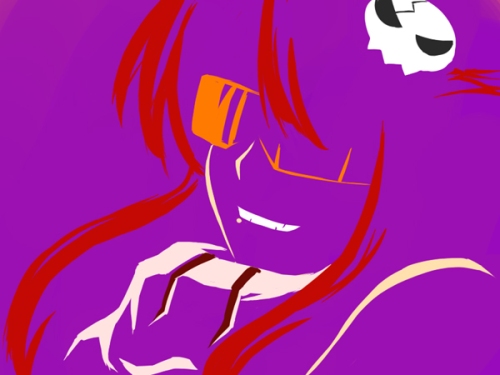Editor’s note: As a nice change of pace to what I’ve been doing here for these three little months, I’ve invited a couple of fairly intelligent friends that are also into anime to contribute to my blog. I trust them to do a good job, and expect that their views will provide a decent contrast to mine. This also will help when I’ll have no/little time to do the blogging, as I’m expect that might occur later on. Anyways, here’s nomadotto. Please treat him kindly.
4649 (yo-ro[ku]-shi-kuuuuuuuu) all. I’m your talented host’s crazy friend, Nomad. Because of finals, I’ve been asked to write a little something for the blog, to keep the unwashed still visiting this little corner of the blago-tubes. If you’re looking for interesting analysis of modern anime, you’re still at the right place, so don’t be alarmed by me showing up from time to time. With preliminaries out of the way, it’s time for the meat of today’s post, which are my current two obsessions
As you may or may not know, the third act of BattleMoonWars was released this past Saturday, and I’ve been playing it like some kind of possessed demon-thing. BattleMoonWars, for the unenlightened, is like a mash-up of super robotwars and Type-Moon, which means awesome. For an even more basic explanation, it’s a turn-based strategy game in which you control various characters from the Type-Moon universe in a battle against evil. It’s in Japanese, but most of the game isn’t too hard to read, with only some of the dialog and a special ability or two being un-readable. My suggestion to all you folks out there: Play the game. It might not be everyone’s cup of tea, but it’s a lot of fun, and, if you enjoy this game, you’ll probably also enjoy SuperRobotWars, which will go a long way to getting you familiarized with the kick-ass universe of giant robots and warrior spirit.
Oh, that reminds me of something that I forgot to mention about BattleMoonWars, and that’s the heavy presence of parodic elements within it. A very large percentage of enemies, attacks and abilities are pretty blatantly copied from some other source, in most cases, these are things like Getter Robo and Gundam, but some of the stuff is from sources as far afield as Sailor Moon (Fantis Moon, a.k.a. Arcuied Brunested, the magical girl) and Dragonball. I enjoy the parody here, because it’s mixed with enough original stuff and serious stuff that it’s not just a big joke. Moreover, because the gameplay is disjointed (e.g. There’s a definite “cut” in the game when you move from the dialog to the game map and from the game map to attack execution) you can get away with breaks in tone and mood without harming too much of the game.
This brings me to my second current obsession, tone in anime. It’s a very common problem, because art in general, and film (including things like tv shows), in particular, is all about creating emotional responses to itself. When you have something like a painting or a (non-epic) poem, you only have the space to make a single emotion or two and, since they’re so short, you can’t really get fatigued. However, in longer media, there’s a need to change gears from time to time, because otherwise, your audience gets bored and worn out. You have to take a step back, or else you’re going to end up with nothing but one-oneupmanship. For example, if you’ve just surprised someone in a slasher movie, trying to surprise them again is not only harder, but it requires even more of a shock. Eventually, you’ll have used your big guns, and you’ll be left with nothing. So, instead, you let the mood move down a little, and then hit them again. This formula is repeated time and time again in horror movies: shock relax shock relax ad nasuem.
The problem with this is two-fold. First, when changing the mood, it’s important that you establish boundaries, and, second, you need to make sure that the tone of the work as a whole survives. Let’s begin with the first concern, boundaries. Boundaries allow you to say “this is a sad part and this is a happy part” but much more subtly. By using the standard tools of film, for example, a cut without an establishing shot is mentally part of the same scene, whereas the inclusion of an establishing shot really drives home the point that this is a different portion of the film. This allows you to mentally “key” the viewers in to what mood you’re trying to establish.
The problem with establishing too many boundaries is that the film ceases to flow as a work. Something that’s too choppy isn’t unified, tonally or otherwise, and, so you get something that isn’t a “work” per say. Instead you get successive waves of emotion that add up to nothing. This is especially a problem with TV anime, which have built in breaks for episodes. This means that unless you’re very careful about keeping the tone consistent, you end up with pretty much nothing lasting.
If you’re curious as to what brought this about, it’s caused by the back to back watching of The Girl who Leapt Through Time and Episodes 6 and 7 of Tengen Toppa Gurren Lagann. Basically, I was struck by how much TGWLTT felt like a “work” while Gurren Lagann felt like a bunch of (awesome) stuff put together. My suggestion for fixing this: no more x episodes, where x can be filler or fanservice, or whatever. It breaks up the story and the tone too much, and, when you watch things one after the other, it makes the show look crappier than a film. That’s pretty much all I’ve got to say for today, it’s time to rock out, ‘cus I’ve got no work left!














Spouts of opinion